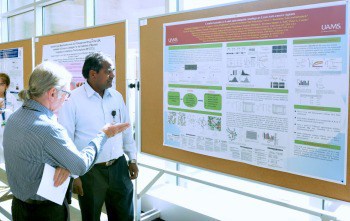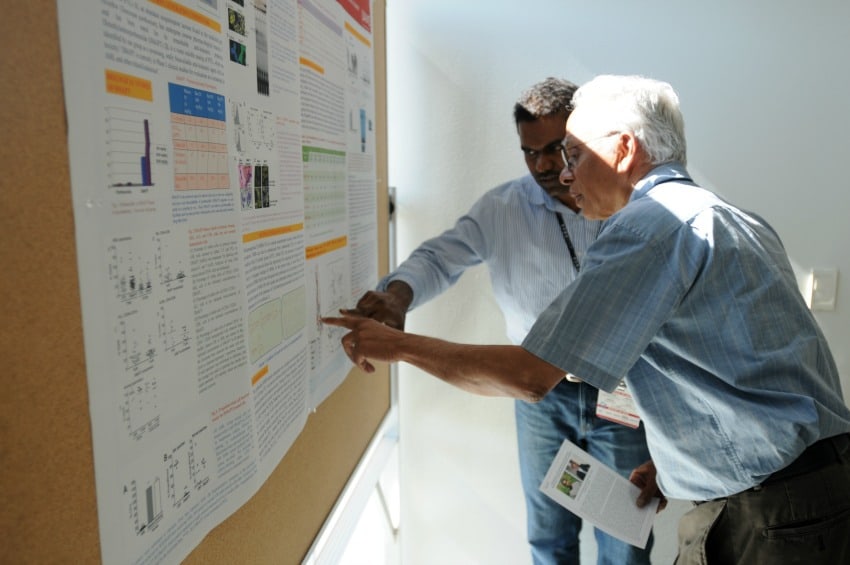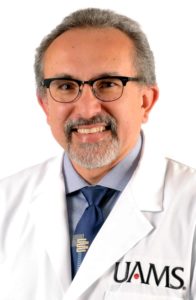Potential patents for medical inventions as small as a molecule prompted big discussions among UAMS researchers who gathered for a showcase hosted June 6 by the College of Medicine to highlight medical research.
“Every poster you see here today has a patent application on file with the Patent and Trademark Office,” said Nancy Gray, Ph.D., director of BioVentures, UAMS’ technology licensing office and business incubator.

Eight projects were featured at the Showcase of Medical Discoveries: Inventors— the 18th in a series to foster communication and collaboration among UAMS investigators and clinicians. About 70 researchers, physicians, staff and students attended the event, held at the UAMS Winthrop P. Rockefeller Cancer Institute.
Each group of researchers had applied for a patent within the last two years, Gray said. Receiving a patent is often a lengthy process that takes several years to complete, she said.
“We are very interested in making sure that research ultimately makes its way to the patient, and it’s not going to make it to the patient if it doesn’t have a commercial path,” Gray said.
“Most faculty in academic health centers think about writing papers and disseminating their research findings through publications, but they don’t always think about protecting their intellectual property,” said Lawrence Cornett, Ph.D., UAMS vice chancellor for research. “The patent is just the beginning, so that you can go forward with the research and no one will steal your idea.”
Many projects focused on small molecule therapies to fight cancer and infection.
A small-molecule drug is a substance that is able to enter cells easily because it has a low molecular weight. Once inside the cells, it can affect other molecules, such as proteins, and may cause cancer cells to die. This is different from drugs that have a large molecular weight, such as monoclonal antibodies, which are not able to get inside cells very easily. Many targeted therapies are small-molecule drugs or small-molecule inhibitors.
Mark Smeltzer, Ph.D., professor in the Department of Microbiology and Immunology and Department of Orthopaedic Surgery, presented his team’s research on using antibiotic-loaded gold nanocages to target staphylococcal infections. Gold nanoparticles are emerging as promising agents for cancer therapy. Smeltzer’s team is using that approach to target infections.

Gold nanocages carry antibiotics to a specific location for treatment, only releasing the antibiotics after the nanocage is targeted with a laser. This releases energy that damages the pathogen, making it easier for the antibiotic to do its work. It’s a one-two punch that aims to combat growing antibiotic resistance, Smeltzer said.
“If you can use it to therapeutic advantage in the context of cancer, why can’t you use it for therapeutic advantage in the context of an infection?” Smeltzer said. “At the end of the day, what you’re trying to do is eradicate some sort of cell that has pathological consequences and do it in a manner that does not harm the human host.”
The Showcase of Medical Discoveries is organized by Cornett and supported by Pope Moseley, M.D., UAMS executive vice chancellor and dean of the College of Medicine. It originated from discussions about the faculty’s desire for more opportunities to display their scientific work in a social setting.
Posters at the showcase described the researchers’ work. They were:
Looking for drugs in all the wrong places: Are antibiotic-loaded gold nanocages the solution for treating Staphylococcus aureus biofilm infections?
Researchers: Daniel Meeker, Karen Beenken, Weston Blake Mills, Dmitry Nedosekin, Mark Smeltzer
Design and Synthesis of Bcl-xL Degraders as Potent Senolytic Agents
Researchers: Xuan Zhang, Yingying Wang, Daohong Zhou, and Guangrong Zheng
Assessing the Interest of UAMS Investigators in fastPACE Biomedical Commercialization Course
Researchers: Nancy Gray, Nancy Rusch, Curtis Lowery
Development and Commercialization of Tocol-containing Pharmaceuticals
Researchers: Ujwani Nukala, Shraddha Thakkar, Awantika Singh, Nukhet Aykin-Burns, Rajeshkumar Manian, John House, Guangrong Zheng, Sanchita Ghosh, Mahmoud Kiaei, Marjan Boerma, Martin Hauer-Jensen, Philip J. Breen and Cesar M. Compadre
Novel Potent Anti-leukemia Stem Cell Compounds
Researchers: Paola E. Ordóñez, Krishan K. Sharma, Laura M. Bystrom, Ujwani Nukala, Rajeskumar Manian, Maria A. Alas, William F. Reynolds, Raul G. Enriquez, Darcy C. Burns, Omar Malagón, Darin E. Jones, Michael Balick, Shraddha Thakkar, Philip J. Breen, Monica L. Guzman and Cesar M. Compadre
Valchlor gel (Mechlorethamine): an approved FDA drug in the USA, and marketed in Europe as Ledaga for the treatment of Mycosis fungoides and cutaneous T-cell lymphoma (MF-CTCL)
Researchers: Zaineb A.F. Albayati, Vipin P. Nair, Sundar Neelakantan, David R. Worthen, Marhaba Hojahmat and Peter A. Crooks
Combretastatin A-4 and Apysinopsin Analogs as Lead Anti-cancer Agents
Researchers: Narsimha R. Penthala, Grace Coggins, Maddukuri Leena; Jessica H. Hartman, Dae Song Jang; Alexei G. Basnakian, Suja Arattuthodiyil, Kevin M. Raney, Nikhil R. Madadi, Thirupathi R. Yerramreddy, Rajashekar Konjeti, Michael L. Freeman, Robert L. Eoff and Peter A. Crooks
Aryl Esters of Melampomagnolide B as Anticancer Agents
Researchers: Shobanbabu Bommagani, Jessica Ponder, Craig T. Jordan, Michael J. Borrelli, Meenakshisundram Balasubramaniam, Robert Reis, and Peter A. Crooks
Sesquiterpene Lactone Derivatives as Potential Lead Molecules for Treatment of Acute Myelogenous Leukemia
Researchers: Venumadhav Janganati, Jessica Ponder, Craig T. Jordan and Peter A. Crooks

UAMS is the state’s only comprehensive academic health center, with colleges of Medicine, Nursing, Pharmacy, Health Professions and Public Health; a graduate school; a hospital; a northwest Arkansas regional campus; a statewide network of regional centers; and seven institutes: the Winthrop P. Rockefeller Cancer Institute, the Jackson T. Stephens Spine & Neurosciences Institute, the Myeloma Institute, the Harvey & Bernice Jones Eye Institute, the Psychiatric Research Institute, the Donald W. Reynolds Institute on Aging and the Translational Research Institute. It is the only adult Level 1 trauma center in the state. UAMS has 3,021 students, 789 medical residents and five dental residents. It is the state’s largest public employer with more than 10,000 employees, including about 1,000 physicians and other professionals who provide care to patients at UAMS, Arkansas Children’s Hospital, the VA Medical Center and UAMS regional centers throughout the state. Visit www.uams.edu or www.uamshealth.com. Find us on Facebook, Twitter, YouTube or Instagram.
###















